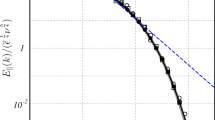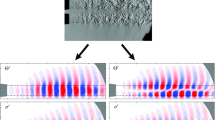Abstract
The performances of a new data processing technique, namely the empirical mode decomposition, are evaluated on a fully developed turbulent velocity signal perturbed by a numerical forcing which mimics a long-period flapping. First, we introduce a “resemblance” criterion to discriminate between the polluted and the unpolluted modes extracted from the perturbed velocity signal by means of the empirical mode decomposition algorithm. A rejection procedure, playing, somehow, the role of a high-pass filter, is then designed in order to infer the original velocity signal from the perturbed one. The quality of this recovering procedure is extensively evaluated in the case of a single tone perturbation (sine wave) by varying both the amplitude and the frequency of the perturbation. An excellent agreement between the recovered and the reference velocity signals is found, even though some discrepancies are observed when the perturbation frequency overlaps the frequency range corresponding to the energy-containing eddies as emphasized by both the energy spectrum and the structure functions. Finally, our recovering procedure is successfully performed on a non-stationary perturbation (linear chirp) covering a broad range of frequencies.













Similar content being viewed by others
References
Bearman PW (1984) Vortex shedding from oscillating bluff bodies. Annu Rev Fluid Mech 16:195–222
Berkooz G, Holmes P, Lumley JL (1993) The proper orthogonal decomposition in the analysis of turbulent flows. Annu Rev Fluid Mech 25:539–575
Brown GL, Roshko A (1974) On density effects and large structure in turbulent mixing layer. J Fluid Mech 54:775–816
Choi H, Jeon WP, Kim J (2008) Control of flow over a bluff body. Annu Rev Fluid Mech 40(1):113–139
Comte-Bellot G, Corrsin S (1966) The use of a contraction to improve isotropy of grid-generated turbulence. J Fluid Mech 25:657–682
Danaila L, Anselmet F, Zhou T, Antonia RA (1999) A generalization of Yaglom′s equation which accounts for the large-scale forcing in heated decaying turbulence. J Fluid Mech 391:359–372
Farge M, Pellegrino G, Schneider K (2001) Coherent vortex extraction in 3D turbulent flows using orthogonal wavelets. Phys Rev Lett 87(5):054501
Foucher F, Ravier P (2010) Determination of turbulence properties by using empirical mode decomposition on periodic and random perturbed flows. Exp Fluids 49:379–390
Frisch U (1995) Turbulence: the legacy of A.N. Kolmogorov. Cambridge University Press, New-York
Gagne Y, Castaing B, Baudet C, Malécot Y (2004) Reynolds dependence of third-order velocity structure functions. Phys Fluids 16(2):482–485
George WK (1992) The decay of homogeneous turbulence. Phys Fluids A 4:1492
Gad-el Hak M (2000) Flow control: passive, active and reactive flow management. Cambridge University Press, London
Hu JC, Zhou Y, Dalton C (2006) Effects of the corner radius on the near wake of a square prism. Exp Fluids 40:106–118
Huang NE, Shen Z, Long SR, Wu WC, Shih HH, Zheng Q, Yen NC, Tung CC, Liu HH (1998) The empirical mode decomposition and the hilbert spectrum for nonlinear and non-stationary time series analysis. Proc R Soc Lond A 454:903–995
Huang YX, Schmitt FG, Lu ZM, L LY (2008) An amplitude-frequency study of turbulent scaling intermittency using empirical mode decomposition and hilbert spectral analysis. Europhys Lett 84:40,010
Hussain AKMF (1983) Coherent structures—reality and myth. Phys Fluids 26(10):2816–2850
Hussain AKMF, Reynolds WC (1970) The mechanics of an organized wave in turbulent shear flow. J Fluid Mech 41:241–258
Lavoie P, Burratini P, Djenidi L, Antonia RA (2005) Effect of initial conditions on decaying grid turbulence at low r λ. Exp Fluids 39:865
Lundgren TS (2002) Kolmogorov two-thirds law by matched asymptotic expansion. Phys Fluids 14(2):638–642
Mazellier N, Vassilicos JC (2008) The dissipation constant is not universal because of its universal dependence on large-scale flow topology. Phys Fluids 20:015101
Mazellier N, Danaila L, Renou B (2010) Multi-scale turbulence injector: a new tool to generate intense homogeneous and isotropic turbulence for premixed combustion. J Turb 11(43):1–30
Pope SB (2000) Turbulent flows. Cambridge University Press, New-York
Qian J (1999) Slow decay of the finite reynolds number effect of turbulence. Phys Rev E 60(3):3409–3412
Rilling G, Flandrin P (2008) One or two frequencies? The empirical mode decomposition answers. IEEE Trans Signal Proc 56:85–95
Schlotthauer G, Torres ME, Rufiner HL, Flandrin P (2009) EMD of gaussian white noise: effects of signal length and sifting number on the statistical properties of intrinsic mode functions. Adv Adapt Data Analys 1(4):517–527
Tennekes H, Lumley JL (1972) A first course in turbulence. MIT Press, Cambridge
Tong C, Warhaft Z (1994) Turbulence suppression in a jet by means of a fine ring. Phys Fluids 6:328
Author information
Authors and Affiliations
Corresponding author
Rights and permissions
About this article
Cite this article
Mazellier, N., Foucher, F. Separation between coherent and turbulent fluctuations: what can we learn from the empirical mode decomposition?. Exp Fluids 51, 527–541 (2011). https://doi.org/10.1007/s00348-011-1069-3
Received:
Revised:
Accepted:
Published:
Issue Date:
DOI: https://doi.org/10.1007/s00348-011-1069-3




